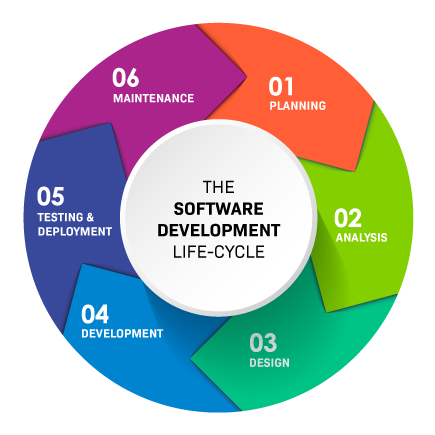SDLC is a compilation of processes that contribute to software development. The methodology consists of six stages that have an impact on the final result of the solution. We decided to look at each of these phases and determine its contribution to the whole cycle. Learn about activities that will help you understand how to create better products in less time.
Table of Contents:
1. What is Software Development Life Cycle (SDLC)?
1.1. What are the 6 phases of SDLC?
What is Software Development Life Cycle (SDLC)?
Software Development Life Cycle is a series of activities essential for creating high-quality software. All this at the lowest possible cost and in the shortest possible time. The role of the SDLC is to provide the company with an efficient process of creating software which is tested and ready to use.
What are the 6 phases of SDLC?
The Software Development Life Cycle consists of six stages:
- Planning
- Analysis
- Design
- Development
- Testing & Deployment
- Maintenance.
It's a detailed plan of action that allows for effective implementation of goals. It also eliminates all the types of obstacles that are common in software development projects. Understanding the life cycle allows to improve development efficiency and reduce mismanagement. By spreading the whole process over many factors, the company undertakes fully considered actions. Everything is supported by research and analysis.

1. Planning
Planning is the phase where the team clarifies its cost and resource requirements. It's also the right time to define the processes that will be useful in meeting the objectives. Feedback from stakeholders, among other things, is taken into consideration during planning. It's useful to get feedback from customers, programmers or salespeople. Their opinions can significantly ease software development.
2. Analysis
The analysis part is the most important stage of the SDLC. It's the responsibility of the most senior members of the team and is done with whatever data they have. During the analysis, the strengths and weaknesses of the project are debated. Such activities are designed to assess the overall feasibility of the project.
3. Design
At this stage, the description of the expected features and operation of the system takes place. A project's design phase is the time for developing any components. Also, communication with services from third parties is improved. This is a good moment to take care of front-end representations. Design is usually in the Design Specification Document (DSD).
4. Development
The fourth element included in the SDLC is development. This is the stage that determines the actual creation of the software. Development should be supported by the use of access control or source code management applications. Both solutions allow developers to keep track of changes to the code. At the same time they ensure consistency between projects and guarantee meeting the set goals. Software Development Life Cycle in development has the ability to predict any delays resulting from waiting for test results or code compilation. It’s worth emphasizing that software development requires appropriate information flow. Thanks to proper instructions and comments, it is possible to solve any technical problems and streamline work.
5. Testing & Deployment
Any software should be properly tested before being made available to users. The testing process should answer the most important questions about the functionality of the final solution. That is why security or performance tests are indispensable for eliminating bugs that the user might encounter. By eliminating such cases, project teams increase the level of satisfaction from using the software.
6. Maintenance
The delivery of the project does not mean the end of the work at all. Equally important is maintenance, which involves making any regulations in the final phase. Such adjustments made by the maintenance team can be done on an ongoing basis or appear with each new version of the software.
Examples of SDLC models
- Iterative - The characteristic element of this model is the rapid implementation of the initial version of the software by the development team. This is followed by gradual improvement of the project in subsequent versions. Usually this approach can be observed in larger projects where there is a need for a quick software delivery. But, this form of work may involve unplanned resources.
- Agile - The Agile model prioritizes the needs of the customer. This solution focuses heavily on user experience and input. Thanks to the division into cycles, it quickly provides the recipients with the finished product. User feedback in this model has an impact on the next software releases. Despite its visible advantages, Agile also has disadvantages. Too much trust placed in the cooperation with the customer may lead the project in the wrong direction.
- Waterfall - Among the SDLC models, waterfall is among the simplest. It is characterized by the fact that one stage is followed by another. Moreover, each of them has its own separate mini-plan that must be completed. Which makes each completed phase the result of achieving small goals. In the case of waterfall strategy, there is a risk that the lack of realization of minor elements may translate into stopping the process.
- V-shape - this model is derived from two concepts (validation and verification). In verification, requirements and design details are created. Validation has a verification phase associated with it. This is where testing and user acceptance takes place. Both elements are connected by implementation.
Advantages of the SDLC
Well-implemented SDLC allows to achieve full control over management and documentation. Each person working on the project has precisely defined rules of action. But, not everything is as idyllic as it might seem. Misunderstandings can translate into serious mistakes in the initial phase of the project. So, a good functioning Software Development Life Cycle should be based on a consistent following of the plan.


%20(1).jpg)



